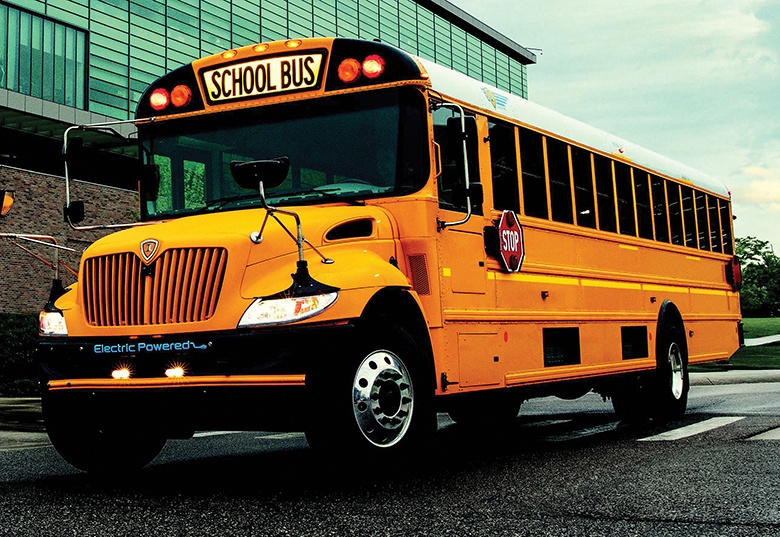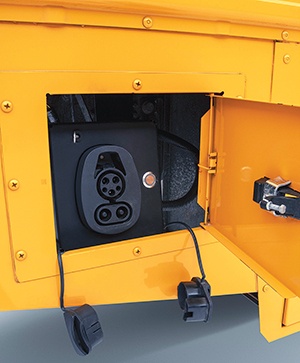
By IC Bus
WHERE ARE YOU ON THE FLEET ELECTRIFICATION ON-RAMP?
Has your organization already developed a comprehensive strategy to convert a portion or all of its fleet to electric school buses (ESBs)?
Or, conversely, have you already received one or more grants yet still have significant research, planning and consensus building to accomplish a seamless transition to a low- or zero-emissions future?
Regardless of your present status, the transition to ESBs and other clean-vehicle technologies is accelerating across North America thanks in part to rapidly growing awareness of the safety, environmental and operational benefits of replacing older, diesel-powered buses.
Of course, the most meaningful catalyst for change has been recent government policy, which has led to an exponential increase in funding – both from national and local sources – available to school bus operators. The Bipartisan Infrastructure Law (2021) allocated $5 billion to districts and other school bus operators investing in zero emission or alternative fuel vehicles, while the Inflation Reduction Act (2022) earmarks more than $1 billion in additional grants for class 6 and 7 vehicles. State-level funding also is on the rise: In 2021, California spent more than $110 million to support fleets in the transition to ESB. While Florida recently authorized funding for seven school districts to purchase a total of 218 zero-emission buses.
 ‘WE’VE SECURED A GRANT! NOW WHAT?’
‘WE’VE SECURED A GRANT! NOW WHAT?’
Transitioning to ESBs or any other transformational technology is indeed a journey comprising several incremental steps that contribute to the ultimate outcome.
While your organization might have received funding very early in the process – perhaps even before selecting an ESB supplier – this does not eliminate the need to complete each step in the journey. In short, implementation of a safe, reliable, environmentally friendly, and cost-efficient new transportation platform that will serve your needs far into the future.
An essential step in this journey is to establish your goals and develop a clearly defined vision for the role of ESBs within your fleet. This is vital not only in understanding how to develop a strategic plan but to gain buy-in from important constituents, from school district leadership to fleet operations personnel to the community at large.
Once you have achieved a consensus among key decision makers, it’s time to conduct a high-level needs assessment.
Your needs assessment should encompass both current, mid-term and long-term needs. For example, if your district is located in a fast-growing area, consider how your fleet would need to scale over the next several years and the impact of changing bell schedules to your operation.
WHAT DOES YOUR DATA TELL YOU?
Another fundamental step is to audit the use of your existing buses. IC Bus® dealers can help you analyze vehicle usage logs and/or telematics data to better understand the miles required from each bus per route and day, dwell time, downtime, topographical features (hills, valleys, etc.) of each route, bell schedules and other variables that should be considered during the planning stage. Consideration of technology performance as well as operational requirements to meet bell schedules and allow for charge events should be assessed early on.
The results of your equipment and route analyses will contribute to your likely next step – establishing a charging strategy. A charging strategy should be based on:
• Individual bus requirements, including daily routes and extended use (after-school activities, etc.)
• Route lengths and operating environment, including external environment impacts
• Time between charges
• Fleet operations structure (centralized/decentralized)
• Main power source (current load / system capacity)
• Utility requirements for electrical upgrade (including possible reimbursement)
• Need for scalability (future expansion of fleet service area)
• IC Bus and its dealers can support this analysis to ensure successful adoption of ESBs.
IC Bus and your charging company can provide comprehensive consulting, infrastructure planning and implementation services for school districts and other school bus operators.
THE CENTER OF IT ALL
Besides the ESBs themselves, the biggest change most school bus operators will experience through electrification is in the bus garage, where they will need ample charging infrastructure to support fleet charging.
The most complex and costly element of this phase is upgrading the power supply and installing all required high- and low-voltage cabling, charging equipment and backup power resources.
As with any sizeable capital project, it is best to invest in the time and outside expertise to design a charging infrastructure that will meet your fleet’s needs for years to come. In navigating this step, you’ll need close collaboration between your fleet operations team, ESB supplier, charging system provider and, above all, your local utility. Together, these partners can help you assess the feasibility of converting/upgrading an existing facility to safely and effectively house and charge your ESBs.
Include your utility as early in the planning process as possible so they understand your electrification goals and can identify and eliminate any power supply constraints. Additionally, they can help offset some of the costs associated with site upgrades with grants and incentive programs available in your area. Other areas of collaboration should include negotiating electric rates for your ESB fleet as well longer-term revenue opportunities associated with vehicle-to-grid (V2G) services.
VEHICLE SELECTION AND BUILD
Soon after receiving grant approval, you will likely formalize the selection and purchase of your new ESB(s). In the ideal scenario, your ESB supplier would be the same company that has helped you navigate through each step of the planning process.
When considering the vehicle manufacturer that best meets your needs, the following should be considered:
• Ensure the charger hardware, charger software, and vehicle are all compatible
• Ensure the battery specification and the battery capacity provides you with the “true” range considering operating environment and vehicle specifications
• With vehicle and hardware software important, ensure the platforms provide the necessary data for Fleet Management, Business Manager, and future reporting requirements
The ESB manufacturer may help you achieve and maintain compliance with the requirements of state, federal and other grants, and incentive programs. When applying for a grant or incentive program, be sure to study and retain a copy of the program manual to understand the guidelines of the contract you are signing. These requirements might dictate the term of your ownership of each new ESB (no less than five years, for example) as well as how each bus may be used. Most grants and incentive programs will require some level of reporting. Discuss these guidelines and reporting needs with the ESB manufacturer to ensure ready access to the information you will need.
EXPERTISE AT EVERY STEP
Your organization might already have put the early building blocks – vision, strategy, timeline, ESB partner, etc. – into place before applying for grants or incentive programs. Others might kick the planning process into gear only after the first grant or incentive program request has been approved. In each case, however, success will depend on the organization’s ability to find partners who can apply their expertise to help ease your journey to electrification.
IC Bus works closely with school districts and other student transportation operators to identify emerging funding sources, including grants and incentives programs available for the purchase of new ESBs as well as certain infrastructure investments.
As a reminder, if your district was awarded funding from round one of the EPA Rebate Program, the deadline to submit a payment request form, incorporating purchase order for the vehicle(s), plus eligible infrastructure is April 28, 2023.
Reach out to any IC Bus dealer for assistance and to learn more.


